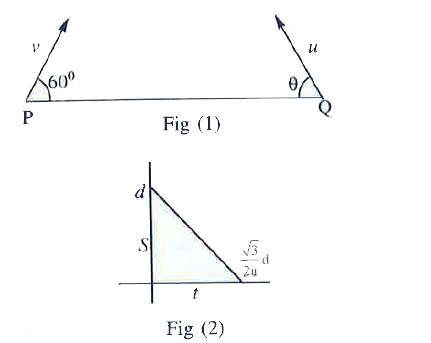The distance between two moving particles P and Q at any time is a. If vr be their relative velocity and if u and v be the components of vr , along and perpendicular to PQ, The closest distance between P and Q and time that elapses before they arrive at their nearest distance is
a(v+vr)v,a(1+vru)2
av(v+vr),a(1+uvr)2
avrv,avru2
avvr,auv2r
The correct Answer is:D
Topper's Solved these Questions
- RIVISION EXERCISEBook:AAKASH SERIESChapter:RIVISION EXERCISEExercise:MOTION IN A PLANE (RELATIVE VELOCITY)
Explore 16 Videos
- RIVISION EXERCISEBook:AAKASH SERIESChapter:RIVISION EXERCISEExercise:MOTION IN A PLANE (A BOAT IN A RIVER)
Explore 10 Videos
- RIVISION EXERCISEBook:AAKASH SERIESChapter:RIVISION EXERCISEExercise:MOTION IN A PLANE (PARALLELOGRAM LAW, TRIANGLE LAW, POLYGON LAW)
Explore 14 Videos
- RAY OPTICS Book:AAKASH SERIESChapter:RAY OPTICS Exercise:EXERCISE III
Explore 64 Videos
- ROTATIONAL DYNAMICS Book:AAKASH SERIESChapter:ROTATIONAL DYNAMICS Exercise:PRACTICE SHEET (ADVANCED) Integer Type Questions
Explore 7 Videos
Similar Questions
A ship is moving due east with a velocity of 12 m/sec, a truck is moving across on the ship with velocity 4 m/sec. A monkey is climbing the vertical pole mounted on the truck with a velocity of 3m/sec. Find the velocity of the monkey as observed by the man on the shore
View SolutionThe velocity of a boat in still water is 10 m/s. If water flows in the river with a velocity of 6 m/s what is the difference in times taken to cross the river in the shortest path and the shortest time. The width of the river is 80 m
View SolutionTwo vectors of equal magnitude P are inclined at some angle such that the difference in magnitude of resultant and magnitude of either of the vectors is 0.732 times either of the magnitude of vectors. If the angle between them is increased by half of its initial value then find the magnitude of difference of the vectors
View SolutionTwo plane mirrors are arranged at right angles to each other as shown in figure. A ray of light is incident on the horizontal mirror at an angle θ For what value of θ the ray emerges parallel to the incoming ray after reflection from the vertical mirror?

View SolutionFour uniform solid spheres each of diameter √5 cm and mass 0.5 kg are placed with their centres at the corners of a square of side 4 cm. The moment of inertia of the system about the diagonal of the square is N×10−4kg m2, then the value of N is .
View SolutionThe distance between two moving particles P and Q at any time is a.If vr be their relative velocity and if u and v be the components of vr, along and perpendicular to PQ.The closest distance between P and Q and time that elapses before they arrive at their nearest distance is
View SolutionA charged particle q is thrown with a velocity v towards another charged particle Q at rest. It approaches Q up to a closest distance r and then returns. If q is thrown with a velocity 2v, what should be the closest distance of approach?
View SolutionThe figure shows a velocity-time graph of a particle moving along a straight line Q. The total distance travelled by the particle is
View SolutionTwo particles P and Q are moving with velocities of (i+j) and (−i+3j) respectively. At time t=0, P is at origin and Q is at a point with position vector (2i+j) .Then the shortest distance between P& Q is:
View SolutionThe distance between the points P (2,a) and Q (6,4) PQ is 5 then a = Will happen-
View SolutionThe distance between P and Q is 100 m and the speeds of A and B are 20 m/s and 30 m/s respectively. Initially A and B are at P.They move between P and Q.calculate.The distance covered by A in first meeting
View Solutionthe distance between two points P and Q is 100 m.A is initially at P and B is at Q.The speeds of A and B is 20m/s and 30 m/s They move between P and Q to and fro:Find the time required for the first meeting
View SolutionA two particles P and Q are separated by distance d apart. P and Q move with velocity v and u making an angle 60∘ and θ with line PQ the graph between their relative separation (s) when time t is shown in figure (2). The velocity v in terms of u

View SolutionThe distance between two moving particles P and Q at any time is a . If v_r be their relative velocity and if u and v be the components of v_r , along and perpendicular to PQ. The closest distance between P and Q and time that elaspse before they arrive at their nearest distance is
View SolutionThe distance between two moving particles P and Q at any time is a. If v_r be their relative velocity and if u and v be the components of v_r , along and perpendicular to PQ, The closest distance between P and Q and time that elapses before they arrive at their nearest distance is
View Solution

